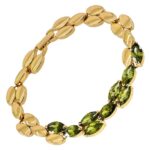The market for handmade jewelry has been thriving in recent years, and many individuals are discovering the potential to turn their passion for creating beautiful pieces into a profitable business. If you have ever wondered how much you can make selling handmade jewelry, you’re not alone.
This article will delve into the various aspects of starting and running a handmade jewelry business, discussing everything from the demand for unique pieces to determining costs and pricing strategies. Whether you are just starting out or looking to expand your existing venture, this article will provide valuable insights and tips to help you succeed in this lucrative industry.
Handmade jewelry holds a special allure for customers who appreciate the uniqueness and craftsmanship that goes into each piece. In a world where mass-produced items dominate the market, many individuals seek out personalized, one-of-a-kind accessories that reflect their individual style and taste.
This demand for unique and customized jewelry creates an excellent opportunity for artisans and entrepreneurs with a flair for creativity to showcase their skills and create stunning pieces that resonate with buyers. As we explore the ins and outs of selling handmade jewelry, we will uncover why it is highly sought after and how you can tap into this thriving market.
Setting up a successful handmade jewelry business requires careful consideration of essential steps to ensure long-term success. From sourcing quality materials to establishing an efficient workflow, each aspect plays a crucial role in your venture’s profitability.
Aspiring jewelry makers need guidance on how best to navigate these initial stages, which is why this article will provide practical tips on setting up your business effectively. Additionally, we will discuss important considerations such as legal requirements, branding, and building a strong online presence through effective marketing strategies.
With these foundational aspects in mind, it is crucial for any handmade jewelry entrepreneur to understand how much it costs to create their products accurately. Determining the cost of making handmade jewelry involves considering factors such as materials used, labor hours involved in crafting each piece, and overhead expenses necessary for operations.
Only by understanding and accurately calculating these costs can you make informed pricing decisions that balance profitability with competitiveness. Throughout this article, we will explore in detail how to determine the true cost of making handmade jewelry and discuss different pricing strategies that can help maximize your earnings.
Join us as we embark on a journey through the world of selling handmade jewelry, where creativity meets business acumen. We will equip you with the knowledge and tools needed to thrive in this thriving market, addressing various aspects such as branding, marketing, sales strategies, online vs. offline selling, success stories, and tips for increasing your sales.
Discover the uncovered potential of turning your passion into a profitable venture and learn how to find fulfillment in creating unique pieces that resonate with individuals seeking accessories as distinctive as they are. So take a leap into possibility – let’s explore how much you can make selling handmade jewelry.
The Demand for Unique and Personalized Pieces
One of the main reasons why handmade jewelry is highly sought after in the market is because of the demand for unique and personalized pieces. In a world where mass-produced items dominate, many consumers are seeking something different and special. Handmade jewelry offers them the opportunity to own something truly one-of-a-kind.
Handmade jewelry allows artisans to express their creativity and put their personal touch into each piece they create. These artisanal creations often feature intricate designs, unique gemstone combinations, or unconventional materials that cannot be found in mass-produced jewelry. This exclusivity and individuality make handmade jewelry highly desirable to consumers who want to stand out from the crowd.
Furthermore, handmade jewelry is often associated with a higher level of craftsmanship and attention to detail. Artisans dedicate their time and effort to meticulously create each piece by hand, resulting in jewelry that is not only beautiful but also well-crafted and durable. This quality and craftsmanship further enhance the appeal of handmade jewelry, as consumers value items that are made with care and skill.
It is also worth noting that handmade jewelry allows for a deeper connection between the consumer and the piece they are purchasing. Many artisans offer customization options, such as engraving initials or birthstones, allowing customers to personalize their jewelry according to their preferences or as meaningful gifts for loved ones. The ability to create a sentimental connection through customization adds an extra layer of value to handmade jewelry.
In summary, the demand for unique and personalized pieces drives the high desirability of handmade jewelry in the market. Consumers seek out these artisanal creations for their exclusivity, individuality, craftsmanship, and ability to evoke sentimental connections. As a result, selling handmade jewelry presents great potential for entrepreneurs who can tap into this thriving market segment.
| Handmade Jewelry | Market Demand |
|---|---|
| Unique designs | High |
| Personalized options | High |
| Craftsmanship and attention to detail | High |
| Sentimental value | High |
Setting Up Your Handmade Jewelry Business
When it comes to starting a handmade jewelry business, there are several essential steps and considerations that can help set you up for success. From developing your designs to finding the right suppliers, here are some key factors to keep in mind.
Firstly, it’s important to define your niche and target market. Determine what makes your handmade jewelry unique and who would be interested in purchasing it. This will help guide your design process and marketing efforts. Conduct market research to identify trends, potential competitors, and pricing strategies within your niche.
Next, you’ll need to gather the necessary tools and materials for creating your handmade jewelry. The quality of your materials can greatly impact the final product, so it’s important to source high-quality supplies that align with the aesthetic of your designs. Research different suppliers and compare prices, ensuring that you have a reliable source for all the components you need.
Once you have your designs and materials in place, consider setting up a dedicated workspace for creating your jewelry pieces. Having a well-organized and efficient work area can greatly increase productivity. Invest in proper tools and equipment that are specific to jewelry making, such as pliers, wire cutters, and bead boards.
In addition to the creative aspects of setting up your business, there are also administrative tasks to address. Registering your business name, obtaining any necessary licenses or permits, and understanding the legal requirements for selling jewelry in your area are all crucial steps. Consult with legal professionals or small business advisors if needed to ensure compliance.
Overall, setting up a handmade jewelry business requires careful planning and attention to detail. By defining your niche, sourcing quality materials, setting up an efficient workspace, and addressing legal considerations early on, you can establish a strong foundation for success.
| Essential Steps | Considerations |
|---|---|
| Define your niche and target market | Conduct market research |
| Gather high-quality materials | Research suppliers and compare prices |
| Create a dedicated workspace | Invest in proper tools and equipment |
| Register your business and understand legal requirements | Consult with legal professionals or small business advisors if needed |
Determining the Cost of Making Handmade Jewelry
One of the essential aspects of running a successful handmade jewelry business is determining the cost of making your products. By accurately understanding and calculating the costs involved in producing each piece of jewelry, you can ensure that your pricing strategy is profitable and sustainable. There are three primary components to consider when determining the cost of making handmade jewelry: materials, labor, and overhead.
- Materials: The cost of materials is a crucial factor in determining your overall production costs. This includes the cost of beads, gemstones, findings, wires, chains, and any other supplies you use to create your jewelry pieces. To accurately calculate the material cost per piece, keep track of how much you spend on each item used and divide it by the number of pieces made from that particular material.
- Labor: The time and effort put into crafting each piece should be accounted for in your pricing strategy. Calculate how much time it takes you to create a single piece of jewelry and determine an hourly rate for your labor. Multiply this rate by the number of hours spent on each piece to get an estimate of your labor costs. It’s important not to undervalue your time and skills when calculating labor costs.
- Overhead: Overhead costs refer to all the expenses associated with running your business that are not directly related to making individual pieces of jewelry. This includes rent for workspace or studio, utilities, insurance premiums, marketing expenses, packaging materials, e-commerce platform fees (if applicable), and any other general operating costs unique to your business.
To accurately determine overhead costs for each piece, divide these expenses by your estimated number of pieces produced within a specific timeframe (e.g., monthly or quarterly). Adding this overhead cost per piece will help you account for these necessary expenses and ensure that they are factored into your pricing structure.
By carefully calculating the cost of making handmade jewelry, taking into account materials, labor, and overhead, you can set competitive prices that reflect the value of your products while ensuring profitability. Remember to regularly review and adjust your costs as your business grows, as market prices for materials may change over time and your production process may become more efficient.
Here is a simplified breakdown of the cost calculation process:
- Material Cost per Piece: (Total material cost / Number of pieces made from that material)
- Labor Cost per Piece: (Hourly rate x Number of hours spent on each piece)
- Overhead Cost per Piece: (Total overhead expenses / Estimated number of pieces produced in a specific timeframe)
Incorporating these costs into your pricing strategy will enable you to achieve a balance between profitability and competitiveness in the marketplace for handmade jewelry.
Pricing Strategies for Handmade Jewelry
When it comes to selling handmade jewelry, one of the most critical aspects is determining the right pricing strategy. Finding the sweet spot between profitability and competitiveness can make all the difference in the success of your business. Here are some key factors to consider when developing your pricing strategy:
Cost of Materials and Labor
The first step in calculating the price of your handmade jewelry is to determine the cost of materials and labor. Consider how much you paid for each material used in creating a piece, including gemstones, beads, wires, clasps, and any other components. Additionally, factor in the time it takes to create each piece. It’s important to ensure that you are covering not only the cost of materials but also adequately compensating yourself for your time and skill.
Overhead Costs
In addition to materials and labor, don’t forget to include overhead costs when determining your pricing. Overhead costs may include expenses such as packaging materials, studio rent or utilities if you have a dedicated workspace, tools and equipment maintenance, advertising and marketing expenses, website hosting fees (if applicable), and any other costs associated with running your handmade jewelry business. It’s essential to allocate a portion of these expenses into each piece you sell.
Market Research
To find the sweet spot between profitability and competitiveness, conducting market research is crucial. Take the time to explore similar products on various platforms such as online marketplaces or local boutiques. Analyze their pricing strategies and compare their quality with your own creations. This will give you insights into what price range is reasonable for customers while ensuring that you aren’t undervaluing or overpricing your work.
Value Perception
Another aspect to consider when establishing a pricing strategy is how customers perceive the value of your handmade jewelry. Handmade items often have an added appeal due to their uniqueness and personal touch. Highlight these aspects when marketing your products to convey the value that customers are receiving. Creating a strong brand presence and investing in high-quality packaging can also contribute to elevating the perceived value of your handmade jewelry, allowing you to charge higher prices.
Finding the right pricing strategy for your handmade jewelry can take some time and experimentation. It’s important to strike a balance between profitability and competitiveness while considering the market demand and customer perceptions. By carefully considering factors such as materials, labor, overhead costs, market research, and value perception, you’ll be able to set prices that reflect the true worth of your craft and attract customers willing to invest in unique and personalized pieces.
Showcasing and Marketing Your Handmade Jewelry
Building a strong brand presence is essential for showcasing and marketing your handmade jewelry business. By effectively promoting your brand, you can attract potential customers, increase sales, and differentiate yourself from competitors. This section will provide valuable insights and strategies on how to build a strong brand presence for your handmade jewelry business.
Identifying Your Target Market
Before diving into showcasing and marketing your handmade jewelry, it’s crucial to identify your target market. Understanding who your ideal customers are will help you tailor your branding efforts to resonate with them. Consider demographics such as age, gender, location, and interests when defining your target market. Conducting market research or leveraging customer data can provide valuable insights to refine your target audience.
Creating a Compelling Brand Story
Crafting a compelling brand story is key to building a strong brand presence for your handmade jewelry business. Your brand story should connect with customers on an emotional level and communicate the unique aspects of your products. Focus on sharing why you started making handmade jewelry, the inspiration behind each piece, and any meaningful stories related to your creations. Incorporate personal anecdotes or experiences that highlight the passion and craftsmanship behind your work.
Investing in High-Quality Product Photography
In the digital age, visual content plays a vital role in attracting customers to your handmade jewelry business. Invest in high-quality product photography that showcases the intricate details of each piece. Hiring a professional photographer or investing in photography equipment can significantly elevate the overall presentation of your brand. Consistency in style and aesthetics across all photographs will contribute to building recognition and credibility for your business.
Social Media Marketing: Harnessing the Power of Online Platforms
Social media platforms serve as powerful tools for showcasing and marketing your handmade jewelry business. Create accounts on platforms such as Instagram, Facebook, Pinterest, or TikTok – depending on where your target audience frequents. Share captivating images of your jewelry, engage with followers by responding to comments and direct messages, and use relevant hashtags to expand your reach. Consider collaborating with influencers or running social media advertisement campaigns to further boost visibility.
Participating in Craft Fairs, Trunk Shows, and Pop-up Events
In addition to online marketing efforts, participating in craft fairs, trunk shows, and pop-up events can provide valuable opportunities for showcasing your handmade jewelry. These events allow you to engage directly with potential customers and receive instant feedback on your products. Be prepared with business cards, samples of your work, and a captivating display booth that reflects your brand’s aesthetics. Connecting face-to-face with customers can help build trust and establish long-lasting relationships.
By implementing these strategies for showcasing and marketing your handmade jewelry business, you can create a strong brand presence that attracts potential customers and drives sales. Remember that building a brand takes time and consistent effort; stay true to your unique style and values while continuously refining your marketing strategies based on customer feedback.
Online vs. Offline Selling
In today’s digital age, the decision to sell handmade jewelry online or offline is an important one for entrepreneurs in this industry. Each avenue has its own advantages and disadvantages, so it’s crucial to consider which option aligns best with your business goals and target market.
One of the major benefits of selling handmade jewelry online is the potential for a wider customer base. With the power of the internet, you can reach customers from all around the world, expanding your market beyond local limitations.
Online platforms also provide convenient and accessible ways for customers to browse and purchase your products at any time. Additionally, setting up an online store is often more cost-effective than establishing a brick-and-mortar shop, as it eliminates expenses such as rent and utilities.
On the other hand, offline selling through physical stores or craft fairs offers unique advantages as well. One key benefit is the opportunity for face-to-face interactions with customers. When customers can see and touch your jewelry in person, they develop a stronger sense of trust and connection with your brand. Offline selling also allows you to showcase your craftsmanship through visually appealing displays and create a memorable shopping experience that can boost customer loyalty.
The decision between online and offline selling ultimately depends on factors such as your target market, budget, and personal preferences. Some handmade jewelry entrepreneurs may choose to combine both approaches, utilizing online platforms to reach a broader audience while also participating in local craft fairs or opening a boutique store. By leveraging both opportunities effectively, you can maximize your chances of success in the competitive handmade jewelry market.
Success Stories
One of the inspiring aspects of starting a handmade jewelry business is the potential for success and substantial earnings. Many entrepreneurs have turned their passion for creating unique pieces into thriving businesses. Let’s delve into a few real-life examples of handmade jewelry entrepreneurs and explore their earnings.
1. Sarah’s Story:
Sarah started her handmade jewelry business from her kitchen table, creating beautiful gemstone bracelets in her spare time. After establishing an online presence through social media platforms and her own website, Sarah’s business began to grow rapidly. Her attention to detail and commitment to quality craftsmanship attracted a loyal customer base. As her popularity increased, Sarah expanded her product range to include necklaces, earrings, and custom-made engagement rings.
Within two years, Sarah was able to quit her full-time job and focus solely on her jewelry business. With consistent sales and growing demand for her designs, she was earning six figures annually. Sarah’s success can be attributed to her dedication to providing exceptional customer service, constantly staying updated on industry trends, and fostering strong relationships with wholesalers for sourcing high-quality materials at competitive prices.
2. Jason’s Journey:
Jason had always been drawn to metalsmithing and decided to turn his passion into a business by creating handmade silver rings. He initially sold his designs at local craft fairs and through word-of-mouth referrals. As his reputation grew, he opened an online store that showcased his intricate designs ranging from simple bands to statement pieces with embedded gemstones.
Over time, Jason built a strong brand presence by positioning himself as an expert in handcrafted silver jewelry. His marketing efforts included collaborations with fashion influencers who featured his pieces in their content. As a result, his sales skyrocketed, allowing him to expand his team by hiring skilled artisans within a year.
Today, Jason’s annual earnings exceed $200,000 through online sales alone. His success is a testament to the power of harnessing social media and creating captivating visual content that resonates with his target audience.
3. Maria’s Milestones:
Maria started her handmade jewelry business as a side hustle during her college years. Scouring local flea markets for unique vintage pieces, she began repurposing them into one-of-a-kind statement necklaces. With a background in marketing, Maria understood the importance of branding and storytelling. She carefully curated each piece and incorporated stories about their origin, giving customers a sense of nostalgia when wearing her creations.
Her talent for storytelling, combined with her eye-catching designs, captivated customers both online and at artisan markets. As demand increased, Maria expanded her team to keep up with production while ensuring consistent quality. Within three years, Maria’s earnings exceeded $100,000 annually, allowing her to work full-time on her jewelry business.
These success stories highlight the potential for considerable earnings in the handmade jewelry industry. However, it is essential to note that each entrepreneur’s journey is unique and requires hard work, determination, and strategic decision-making to achieve such results. With creativity, attention to detail, diligent market research, and a strong brand presence, aspiring handmade jewelry entrepreneurs can set themselves up for financial success while doing something they love.
Tips for Increasing Your Handmade Jewelry Sales
One key aspect of running a successful handmade jewelry business is finding ways to increase your sales. Whether you’re just starting out or have been in the industry for some time, implementing effective strategies can help you reach a wider audience and boost your profits. Here are some valuable tips for increasing your handmade jewelry sales:
Building Relationships
Building strong relationships with your customers is essential for the success of your handmade jewelry business. By cultivating a loyal customer base, you not only increase the likelihood of repeat purchases but also benefit from word-of-mouth advertising.
- Offer personalized customer service: Take the time to connect with each customer and understand their preferences. Respond promptly to inquiries and provide excellent post-purchase support.
- Create a loyalty program: Encourage repeat business by rewarding loyal customers with special discounts, exclusive promotions, or access to limited-edition pieces.
- Participate in craft shows and local events: Attend craft fairs, markets, or festivals in your area to meet potential customers face-to-face. This allows you to create personal connections and showcase your unique creations.
Expanding Your Product Range
Expanding your product range is another effective way to increase sales. Offering a variety of styles, designs, and price points will attract a wider range of customers and cater to different tastes and budgets.
- Introduce new product lines: Research trends in the jewelry industry and experiment with different materials or techniques to create fresh designs that appeal to current market demand.
- Consider collaborations: Partnering with other artisans or designers can bring innovative ideas and expand your offerings beyond just jewelry. Collaborations provide an opportunity for cross-promotion and reaching new audiences.
- Customize options: Provide customization options such as personalized engravings or birthstone additions. This allows customers to feel a greater sense of ownership of their jewelry and boosts its sentimental value.
By focusing on building relationships with customers and expanding your product range, you can increase your handmade jewelry sales and create a thriving business. Remember to continuously assess market trends and adapt your strategies accordingly, ensuring that you stay competitive in the ever-evolving marketplace.
Conclusion
In conclusion, selling handmade jewelry can be both financially rewarding and emotionally fulfilling. As discussed throughout the article, there is a thriving market for unique and personalized pieces, with high demand from consumers who appreciate the craftsmanship and individuality that handmade jewelry offers. By setting up your handmade jewelry business with careful consideration of materials, labor, and overhead costs, you can determine a pricing strategy that strikes the right balance between profitability and competitiveness.
Additionally, showcasing and marketing your handmade jewelry plays a crucial role in building a strong brand presence. Whether you choose to sell online or offline, there are pros and cons to consider. Online platforms provide a global reach and convenience for customers, while offline selling allows for more personal interactions and opportunities for building relationships with local customers.
Looking at real-life success stories of handmade jewelry entrepreneurs highlights the potential earnings that can be achieved with dedication and creativity. By taking steps to increase your sales such as building relationships with customers and expanding your product range, you can further enhance your income potential.
Overall, selling handmade jewelry offers not only financial rewards but also a sense of fulfillment. The satisfaction of creating something beautiful with your own hands and seeing it appreciated by others is priceless.
So if you have the passion for jewelry making and entrepreneurship, don’t hesitate to explore the lucrative potential that this industry holds. With careful planning, hard work, and creativity, you can turn your love for crafting into a profitable business venture that brings both financial stability and personal satisfaction.
Frequently Asked Questions
Does homemade jewelry sell well?
Homemade jewelry can indeed sell well, depending on various factors. The market for handmade jewelry is quite diverse and encompasses a wide range of styles and aesthetics. Customers often appreciate the uniqueness and personal touch that comes with homemade pieces.
However, success in selling homemade jewelry depends on factors such as quality, design, pricing, marketing efforts, and target audience appeal. Additionally, staying updated with current trends and creating designs that stand out can contribute to its marketability.
Is it profitable to sell handmade jewelry?
Selling handmade jewelry can be profitable, but it largely depends on several factors like expenses, pricing strategies, market demand, competition, and business efficiency. While the profit margin for handmade jewelry tends to be higher compared to mass-produced items due to the exclusivity and craftsmanship involved, it’s important to consider overhead costs such as materials, tools, packaging supplies, marketing expenses, and any fees associated with online or retail platforms.
Analyzing the potential demand for your products and strategically pricing them accordingly can help maximize profitability.
How much can you sell handmade jewelry for?
The selling price of handmade jewelry varies greatly depending on various factors such as design complexity, materials used, perceived value by customers, brand recognition (if any), target market preferences, competitive pricing in the marketplace, location (online vs. physical store), and other specific considerations. Handmade jewelry prices can range from a few dollars for simple designs using affordable materials to hundreds or even thousands of dollars for intricate or precious gemstone pieces crafted by renowned artisans or designers.
Conducting thorough market research on comparable products within your niche will help determine a suitable price range that balances customer perception with profitability goals

Welcome to my jewelry blog! My name is Sarah and I am the owner of this blog.
I love making jewelry and sharing my creations with others.
So whether you’re someone who loves wearing jewelry yourself or simply enjoys learning about it, be sure to check out my blog for insightful posts on everything related to this exciting topic!





